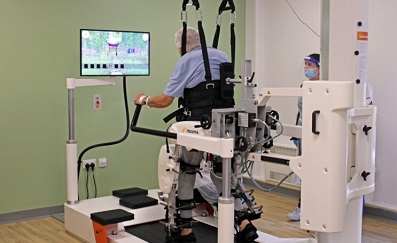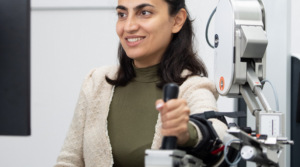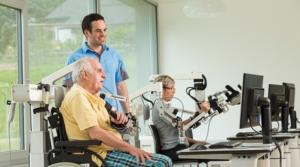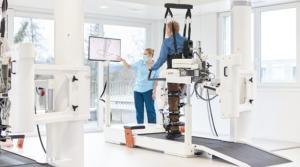National Clinical Guideline for Stroke supports robotic movement therapy
News
The National Clinical Guideline for Stroke for the United Kingdom and Ireland have released their latest guidelines for 2023. These guidelines are shared to make a difference to clinical practice and stroke recovery outcomes. Click here to read the full guidelines.
As the UK distributor for world-leading rehabilitation technology providers, Summit Medical and Scientific welcome the guideline’s recommendations for upper and lower limb movement therapy using robotics and electromechanical gait trainers.
Read on to find out more about the latest stroke guidelines, and get in touch today to discuss our clinical technology solutions.
Upper limb rehabilitation
Approximately 70% of people experience loss of arm function after a stroke, and this persists for about 40%.
Whilst research regarding interventions to promote motor recovery has progressed, continued focus is required to ensure these are implemented into practice. Intensity of practice of movements and tasks during therapy must be coupled with efforts to translate movements into everyday activities. Current practice in the UK indicates too few rehabilitation sessions are dedicated to the upper limb and within sessions too few repetitions are achieved (Stockley et al, 2019). A co-ordinated multidisciplinary approach should be taken to maximise upper limb rehabilitation as well as ensuring that people are supported to practise outside of therapist-delivered sessions.
A robot is defined as a reprogrammable, multifunctional manipulator designed to move material, parts, or specialised devices through variable programmed motions to accomplish a task (Chang & Kim, 2013). Robot-mediated treatment uses devices to provide passive, active-assisted or resistive limb movement, and has the potential to offer extended periods of treatment and an opportunity to increase intensity through repetition. Some robots may be able to adapt treatment in response to performance.
Recovery of the upper limb is best achieved through training that involves repetition of functional tasks and targeted exercises that follow motor learning principles. Components of functional tasks may be practised but should then be incorporated into practice of the whole functional task. Training should be supplemented with aids and equipment as necessary to enable safe, intensive and functionally relevant practice.
People with reduced arm function after a stroke may be considered for robot-assisted movement therapy to improve motor recovery of the arm as an adjunct to usual therapy, preferably in the context of a clinical trial.
Lower limb, gait and balance rehabilitation
Approximately half of people with stroke are unable or are limited in their ability to walk.
Although most regain some mobility, few regain their previous level. Impaired speed, endurance and energy efficiency often limit activity and participation even in those who are independently mobile. Unsurprisingly, walking is a high priority for many people after a stroke and enables increased independence in functional tasks and participation. This section of the guidelines focuses on treatments and equipment to improve walking, the basis of which should be intensive practice of walking and exercise using aids and equipment as necessary to enable safe practice and mobility during usual activities (such as treadmills, electro-mechanical gait trainers, activity and heart rate monitors).
Walking practice at a level that promotes cardiovascular training builds motor skills, strength and cardiovascular fitness which enables greater activity in everyday life. Real-world walking is an important aspect of rehabilitation and is often a goal identified by people with stroke who need to traverse uneven ground, walk dogs or manage inclines.
People who cannot walk independently after stroke should be considered for electromechanical-assisted gait training including body weight support.
People with stroke who are able to walk (albeit with the assistance of other people or assistive devices) and who wish to improve their mobility at any stage after stroke should be offered access to equipment to enable intensive walking training such as treadmills or electromechanical gait trainers. To achieve this, training needs to be at 60-85% heart rate reserve (by adjustment of inclination or speed) for at least 40 minutes, three times a week for 10 weeks.
Pioneering the NHS rehabilitation revolution with robotics
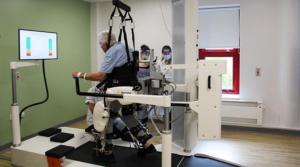
“We should be looking at how we can enhance rehabilitation with robotics, and deliver rehabilitation that is enabled by technology as much as possible.” – Dr Louise Johnson, University Hospitals Dorset.
Summit Medical and Scientific customers like the University Hospitals Dorset are already implementing the National Clinical Guideline for Stroke recommendations to provide electromechanical-assisted gait training for their stroke patients.
Royal Bournemouth Hospital’s Acute Stroke Unit fundraised to purchase a Hocoma Lokomat electromechanical gait trainer for their acute stroke patients back in 2021. Read why – and how – they did it on the Stroke Rehab Times: Part 1; Part 2 and Part 3.
“We are always striving to make sure that we are progressing the way that we deliver rehab and keeping the profile of rehab high.
I think as a service we are quite proactive at thinking about how we can do things better, how we can integrate research evidence into practice, and make sure the evidence is translated into practice. I’d been to a few conferences where robotic gait training was talked about, so over time we felt we shouldn’t ignore it. We shouldn’t skim over it in our national guidelines just because we feel it might be out of reach, or too difficult, or too expensive for us to be able to offer.
We didn’t know that we would end up getting an electromechanical gait trainer like the Lokomat, and that our [fundraising] campaign would be successful, but we wanted to make sure that we had at least considered it for our patients.
The evidence around robotic gait training is strongest for people who are more impaired after stroke, and who are in the early phase after stroke. That’s exactly the group of patients that we see on our units, day in and day out. These patients are hard to deliver good rehab to because it’s difficult and resource-intensive to achieve intensity with patients who are really impaired.
So it seemed like a really good fit and a really good solution to a challenge we have in our day-to-day clinical practice.
… I can’t imagine being without [the Lokomat] now. You can’t imagine going back to what you did before, but you don’t know that until you’ve had the opportunity to use it.”
About Summit Medical and Scientific
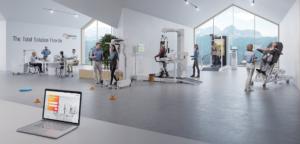
Summit Medical and Scientific are passionate about the power of rehabilitation technology.
We represent clinical technology leaders Hocoma and Motek to provide the total solution for rehabilitation in the UK. Our partners have developed innovative therapy devices using robotics, sensors and virtual reality for evidence-based early and acute rehabilitation, gait and balance therapy, arm and hand therapy, body weight support and more.
To find out more about incorporating state-of-the-art devices into your clinical practise, please contact us via email at info@summitmedsci.co.uk or call 01372 3459863.
You can also follow us on Facebook, Twitter and LinkedIn, and subscribe to our newsletter for the latest updates.

